Welcome to the future of poultry farming, where technology takes center stage in optimizing operations for efficiency and sustainability. In this blog, we’ll explore the transformative impact of integrating cutting-edge technologies in poultry farming. From smart sensors monitoring health parameters to automated feeding systems, these innovations not only streamline tasks but also enhance overall productivity.
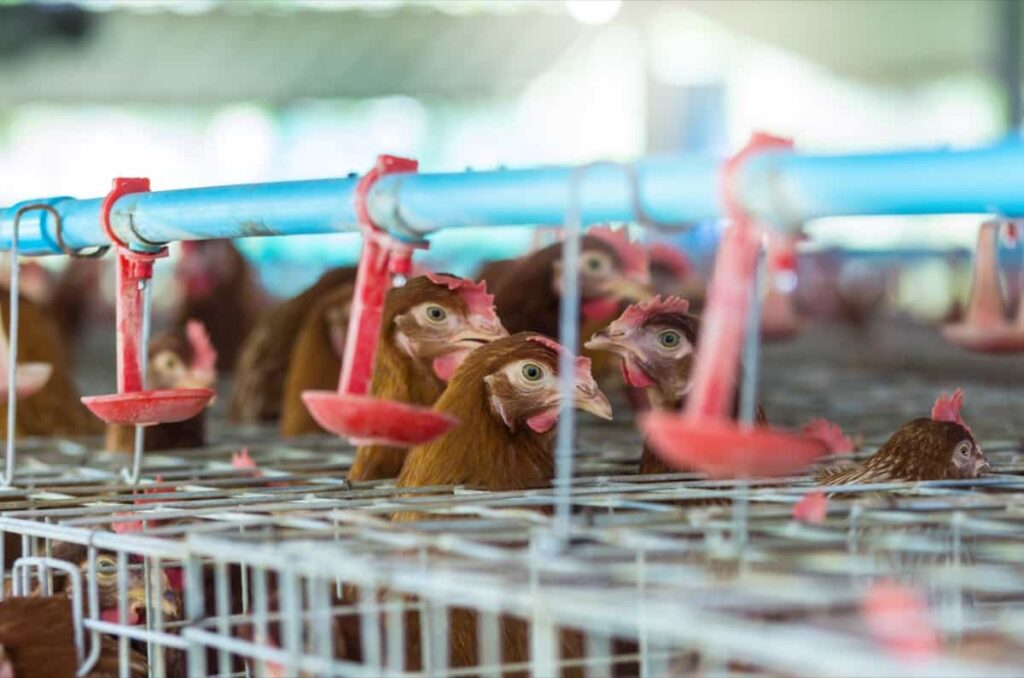
What is Integrating Technology in Poultry Farming?
Integrating technology in poultry farming is the process of using modern tools and methods to improve the efficiency and productivity of raising chickens, turkeys, ducks, and other birds. Some examples of technology in poultry farming are automated feeding systems, environmental control systems, health monitoring systems, and smart egg collection systems. These technologies can help farmers reduce labor costs, increase animal welfare, optimize feed conversion, and enhance product quality.
Automated Feeding Systems in Poultry Farms
Poultry farming is a major source of protein production and income generation for many people around the world. However, it also faces many challenges, such as the high cost of feed, labor-intensive operations, disease outbreaks, and environmental issues. An automated feeding system is a system that delivers feed and water to birds at specific intervals and quantities. It consists of a feed storage unit, a feed delivery unit, a feed dispensing unit, a water supply unit, a sensor unit, and a control unit.
The benefits of using an automated feeding system in poultry farms include reduced labor costs, improved feed efficiency, enhanced animal welfare, and optimized farm management. Examples of automated feeding systems include the Korea Superconducting Tokamak Advanced Research facility’s automated poultry feeding system, AGICO’s automatic feeding system, and Cosmas U.
In case you missed it: Poultry Farm Income Per Month in India: Profit Calculation and Income Tax on Poultry Farm Income
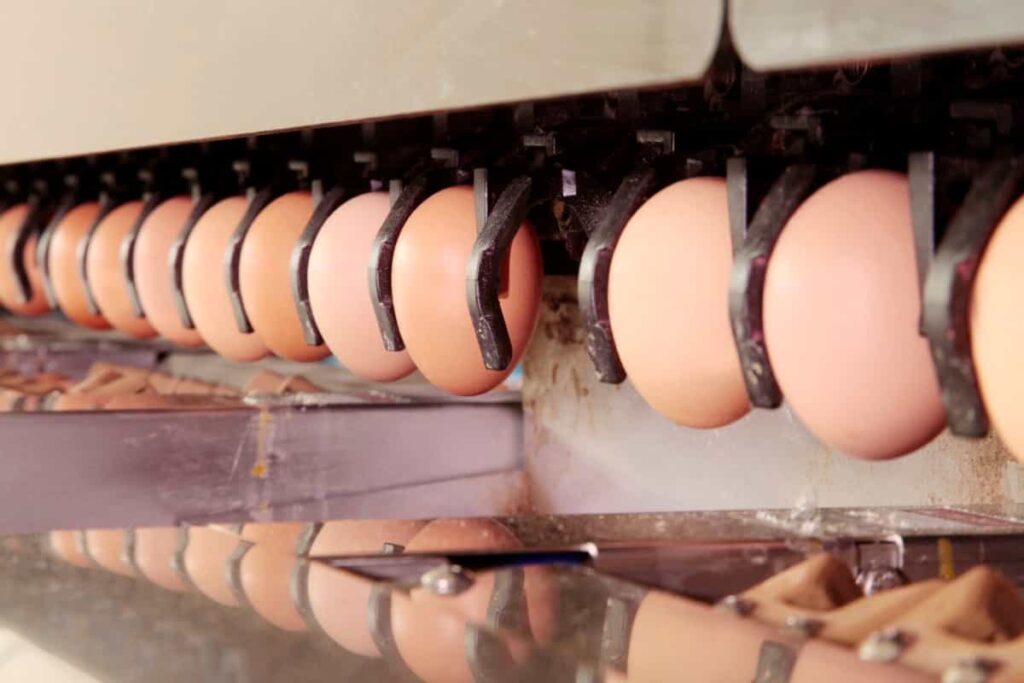
Ogbuka et al.’s robotic feeding system. The KSTAR facility uses an Arduino Uno microcontroller to predict feed and water levels with an accuracy of 98.79%, AGICO uses an automatic feeding machine to dispense feed into troughs, and Cosmas U. Ogbuka et al. proposed a robotic feeding system using a robotic arm to pick up feed from a hopper and place it into a feeder.
Environmental Control Systems in Poultry Farms
Environmental control systems are crucial for providing the optimal thermal environment for poultry, affecting their behavior, welfare, health, and productivity. These systems include natural and mechanical ventilation, heating, cooling, and evaporative cooling pads, which regulate temperature, humidity, air quality, and lighting in poultry houses. Advantages of these systems include reducing feed conversion ratios, preventing heat stress, cold stress, and respiratory diseases, reducing ammonia emissions, enhancing biosecurity and hygiene, and reducing labor costs.
However, challenges include high initial investment and maintenance costs, reliance on reliable power supply and internet connectivity, potential technical issues or malfunctions, and adaptation to different climatic conditions, building typologies, and poultry breeds. Despite these challenges, environmental control systems offer numerous benefits, including improved feed conversion ratio, reduced heat stress, reduced respiratory diseases, reduced ammonia emissions, enhanced biosecurity, and reduced labor costs.
Health Monitoring Technologies in Poultry Farms
Health monitoring technologies are crucial in detecting, diagnosing, and preventing diseases in poultry, which can lead to economic losses, food safety issues, and animal welfare problems. These technologies include biosensors, rapid assays, computer vision, sound analysis, wearable sensors, and artificial intelligence. They collect, transmit, and analyze data about the physiological, behavioral, and environmental parameters of poultry.
The advantages of these technologies include providing real-time, accurate, and non-invasive information about the health status of individual or group poultry, identifying early signs of disease or stress, reducing antibiotic use, improving traceability and quality assurance of poultry products, and enhancing efficiency and productivity in poultry farming.
In case you missed it: Poultry Farm Design: Low-cost Layout Plans and Required Poultry Farming Equipment
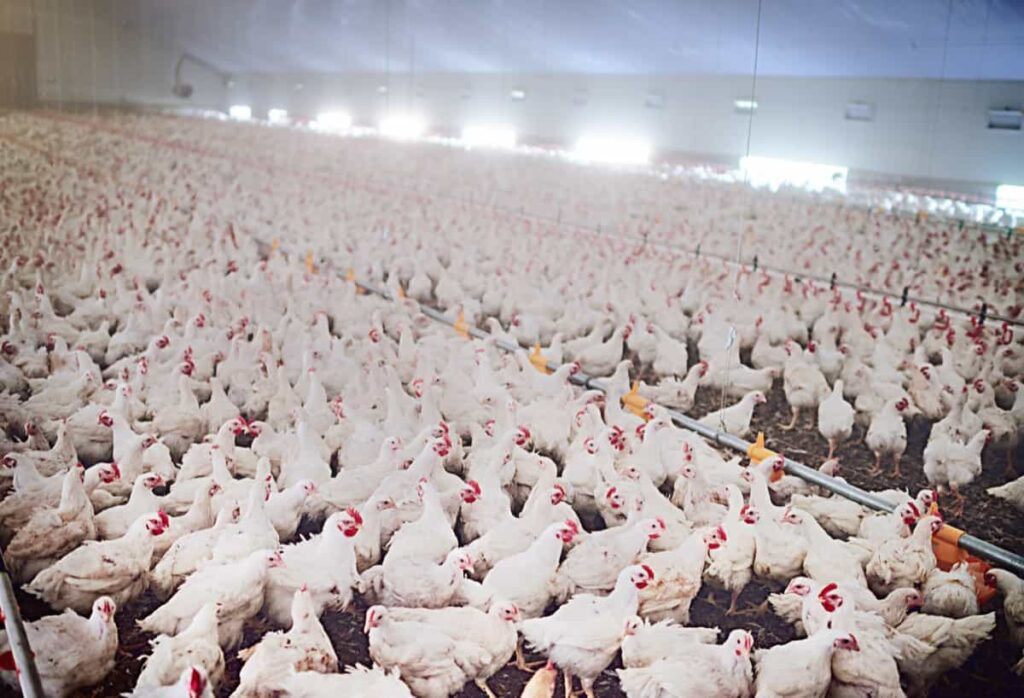
However, challenges include high initial investment and maintenance costs, reliance on reliable power supply and internet connectivity, potential technical issues or malfunctions, and the need for validation, calibration, and standardization for different diseases, breeds, and production systems.
Data Analytics for Performance Tracking in Poultry Farms
Data analytics is a crucial tool in poultry farming, enabling farmers to gather, analyze, and interpret data to make informed decisions. It can be applied to various aspects of poultry farming, including production, health, welfare, and environmental impact. Automated tracking systems, using cameras and AI, can help farmers monitor and optimize the performance of their flocks, identify potential problems, and improve product quality and profitability.
Feed conversion ratio (FCR) is another application of data analytics, indicating how efficiently birds convert food into body mass. A low FCR indicates faster growth with less feed, reducing production costs and environmental impact. Data analytics can help farmers track FCR, adjust feed composition, and compare breeds or strains. Mortality rate, the percentage of birds that die, is another application of data analytics. A high mortality rate indicates issues with disease, injury, predation, or management practices.
Automated Egg Collection Systems in Poultry Farms
Automated egg collection systems are devices that collect eggs from laying hens and transport them to a central location for processing. These systems can enhance efficiency, productivity, and profitability in poultry farms by reducing labor costs, egg breakage rates, and contamination risks. Different types of automated egg collection systems, such as belt, rod, chain, or elevator systems, have their advantages and disadvantages. Common benefits include gently collecting eggs, reducing breakage rates, preventing broken eggs from entering the system, reducing noise, saving time and workforce, and being customizable.
However, challenges include high initial investment and maintenance costs, potential malfunctions due to mechanical or electrical issues, compatibility with certain cages or housing systems, and the need for regular cleaning and disinfection. Despite these challenges, automated egg collection systems are crucial for modern poultry farming, helping farmers increase profits and competitiveness.
Remote Monitoring and Control in Poultry Farms
Remote monitoring and control in poultry farms involves the use of wireless sensors, mobile networks, and IoT devices to collect real-time data on the poultry environment and feed dispensing system. This technology can improve efficiency, productivity, and profitability by reducing manual labor, saving time, enhancing animal welfare, and preventing diseases and losses.
In case you missed it: Chicken Farming in India: Poultry Farming Cost, License, and Requirements to Start in India
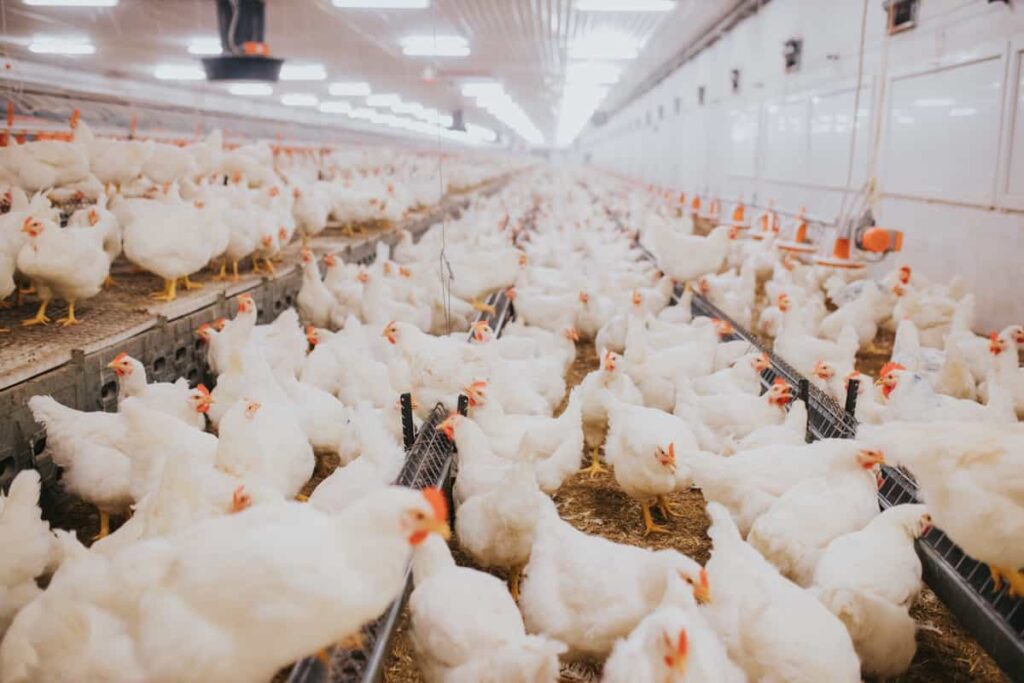
Examples of remote monitoring systems include GSM-based feed dispensing systems, which automatically dispense feed based on weight and age, monitoring feed levels and consumption, and sending SMS messages to farmers when feed is low or malfunctioning. Wireless sensors and IoT devices can also monitor water, food, temperature, humidity, and ammonia gas levels in the farm, sending data to a cloud server and mobile application. RFID tags can help optimize feed ratio, detect diseases or stress early, reduce mortality, and improve traceability.
Precision Livestock Farming in Poultry Farms
Precision Livestock Farming (PLF) is a technology-based approach that helps farmers monitor and manage their animals and their farms, improving animal welfare and increasing production efficiency. PLF systems use technologies like sensors, cameras, and microphones to collect real-time data on birds’ health, behavior, and environmental conditions. Benefits of PLF include early detection of diseases, optimizing feed and water intake, assessing flock uniformity, and automation and robotics for improved biosecurity and safety.
However, challenges include high initial investment and maintenance costs, data integration and analysis, and ethical and social issues like data privacy, animal rights, and consumer acceptance. PLF is still in its early stages of development and implementation, and more research is needed to validate the accuracy and reliability of these technologies and evaluate their impact on animal welfare and production efficiency.
Biosecurity Solutions in Poultry Farms
Biosecurity is a set of measures and practices aimed at preventing and spreading the spread of infectious diseases in poultry farms. These solutions protect the health and welfare of poultry, reduce the risk of zoonotic diseases, and improve productivity and profitability. Examples include strict hygiene protocols, isolation of sick birds, vaccinations, pest control, safe disposal of waste materials, and regular monitoring and testing of flock health and performance. These solutions help protect the health and welfare of poultry, reduce the risk of diseases, and improve the productivity and profitability of poultry farming.
Waste Management Technologies in Poultry Farms
Waste management in poultry farms involves collecting, treating, and disposing of waste materials generated by the industry. These technologies can reduce environmental impact, improve product quality and safety, and create value-added products. Examples include composting, which decomposes organic waste into nutrient-rich soil amendment, improving soil fertility and crop yield, and suppressing plant pathogens and weeds.
Anaerobic digestion converts waste into biogas and digestates, producing renewable energy, and reducing greenhouse gas emissions. Pyrolysis, the thermal decomposition of organic waste, produces biochar. These technologies help reduce environmental impact, enhance product quality, and create value-added products from waste materials.
Robotics in Poultry Handling in Poultry Farms
Robotics is a technology that automates tasks in various industries, including poultry production. It can handle repetitive tasks like feeding, egg collection, manure removal, deboning, and monitoring bird health and welfare. Robots can perform these tasks more efficiently, safely, and accurately, enhancing the efficiency and safety of poultry farming operations.
In case you missed it: Month-Wise Poultry Farm Operations Maintenance and Management For Better Profits
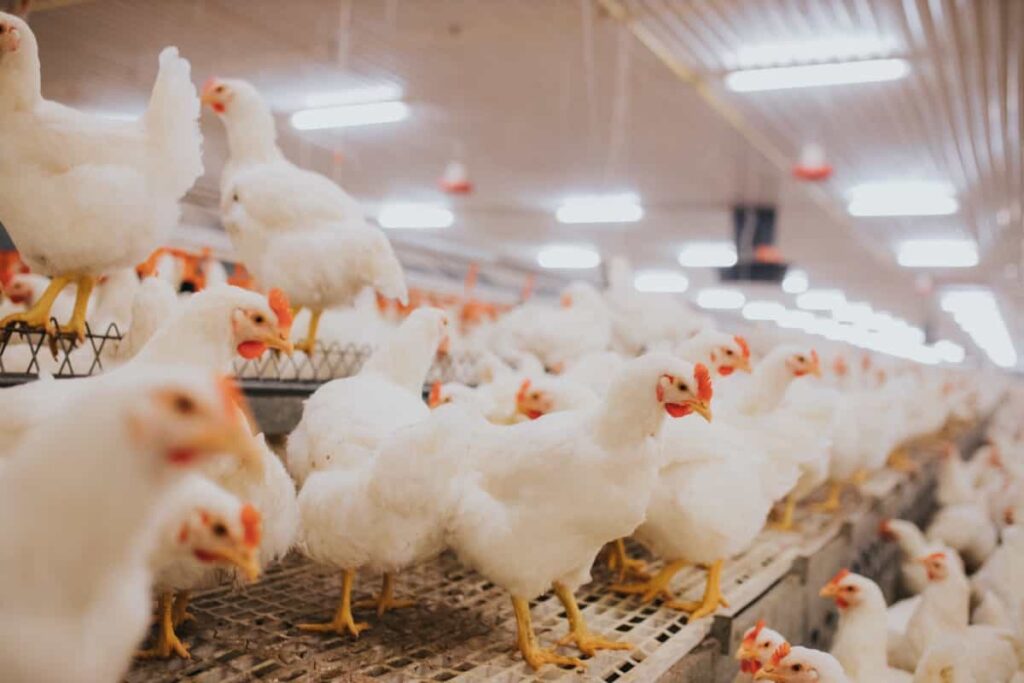
Examples include robot feeders that deliver feed according to bird needs, robot egg collectors that transport eggs, robot egg graders that sort eggs using sensors and cameras, and robot deboners that cut chicken meat using AI and machine learning. Additionally, robot environmental controllers adjust ventilation, temperature, humidity, and gas levels in the poultry house, and robot welfare monitors check for signs of stress, disease, or injury in birds.
Water Quality Monitoring Systems in Poultry Farms
Water is crucial for poultry farming, affecting health, growth, and productivity. Poor water quality can lead to reduced feed intake, impaired digestion, increased disease susceptibility, and lower performance. Farmers need to monitor and control parameters like pH, temperature, turbidity, hardness, chlorine, and microbial load to ensure optimal water quality.
Traditional methods involve manual sampling and testing, which can be labor-intensive, time-consuming, and prone to human errors. Smart sensors Internet of Things (IoT) devices can be installed in water tanks or pipelines to measure and wirelessly send data about water quality to a mobile app or central system.
Farmers can access real-time data and trends, receive notifications for deviations or anomalies, and automatically modify water parameters or initiate remedial measures. Artificial intelligence and machine learning can evaluate vast volumes of data on water quality and offer suggestions for better water management. DNA-based testing uses molecular methods to determine the presence and amount of specific microbes in water samples, providing faster and more precise results than traditional techniques.
Smart Hatchery Technologies in Poultry Farms
SmartSet Pro: A smart incubator developed by Pas Reform that uses adaptive control technology to adjust the incubation environment according to the needs of each batch of eggs. It also provides real-time data on egg weight loss, temperature distribution, CO2 levels, and humidity levels.
HatchTech MicroClimer: A smart hatcher developed by HatchTech that uses laminar airflow technology to create a uniform climate for each egg. It also features a HatchCare system that provides early feeding, drinking, and lighting for the chicks after hatching.
SmartScan: A smart candling system developed by NatureForm that uses high-resolution cameras and artificial intelligence to detect the viability of each egg. It also provides data on fertility, embryonic development, blood spots, cracks, and shell quality.
Traceability and Supply Chain Management in Poultry Farms
Poultry farming is a crucial sector in India, contributing to the economy and food security. However, it faces challenges like low productivity, high mortality, poor animal welfare, and environmental impact. To overcome these, farmers need to adopt innovative technologies to optimize operations and enhance profitability.
In case you missed it: How to Start Poultry Farming in Cambodia: Business Plan, Investment, Profit, and Management
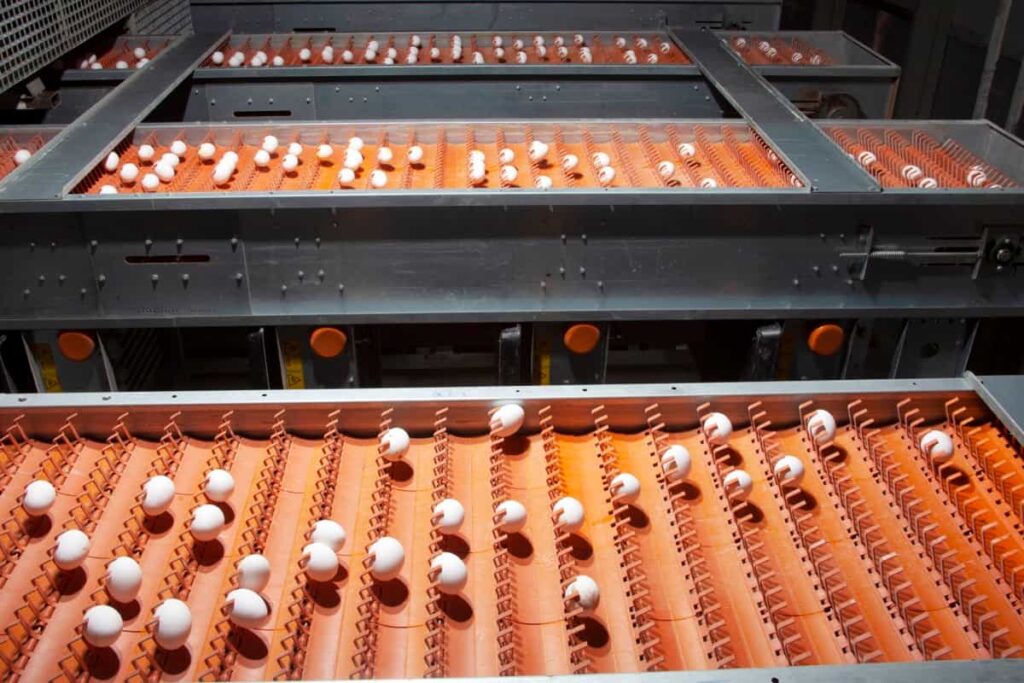
One such technology is traceability and supply chain management, which tracks the origin, movement, and status of poultry products throughout the supply chain. This helps in coordinating and integrating activities involved in producing, processing, transporting, and distributing poultry products.
Integration of IoT (Internet of Things) Devices in Poultry Farms
Poultry farming is a growing sector in India and the world, and to increase productivity and quality, farmers need to monitor and control environmental factors such as temperature, humidity, ammonia, air quality, light intensity, and litter moisture. The Internet of Things technology enables the connection and communication of devices over the Internet, collecting data from sensors, processing it, and sending commands to actuators. By integrating IoT devices in poultry farms, farmers can automate and optimize their farm management.
IoT devices can measure noxious gases, track temperature and humidity, regulate light intensity, detect litter moisture, and track bird location and movement using GPS technologies. Real-time data and alerts can be provided to farmers through web or mobile applications, enabling remote control of farm operations. Integration of IoT devices in poultry farms can improve efficiency, profitability, and sustainability while reducing labor costs, human error, and environmental impact. It can also reduce labor costs, human error, and environmental impact.
Conclusion
The integration of technology in poultry farming is a transformative leap toward efficiency and sustainability. From smart sensors to automated systems, these advancements not only optimize operations but also elevate overall poultry farm management, ensuring a brighter and more productive future.
- Profitable Village Farming Business Ideas in 2024
- High-Yield Aquaculture: Fast-Growing Fish for Farming
- Effective Fish Pond Construction Techniques for Beginners
- Irrigation and Water Management in Pineapple Farming
- Blossom to Harvest: Mastering Flowering and Pollination in Papaya Farming
- Pig Fattening Essentials: From Selection to Sale for Beginners
- Raising Wagyu Cattle: A Complete Guide for Premium Beef Production
- Soil Types and Their Water Holding Capacity
- Optimizing Irrigation Schedules for Coconut Groves for Enhanced Yield
- Espresso Your Garden: Coffee Grounds for Healthier Acid-Loving Plants
- The Best Soil Mix for Snake Plants: How to Mix Your Own Snake Plant Soil
- Green Thumb Success: Expert Tips for Cultivating Greenhouse Beans All Year Round
- Bloom All Year Round: The Ultimate Guide to Indoor Hyacinth Care
- Eco-Friendly Gardening: How to Make Liquid Fertilizer from Kitchen Waste
- Ultimate Guide to Grow Anise in Pots: Explore Seed Propagation to Harvesting
- Guide to Raising Chester White Pigs: Discover Breed Facts to Growth Management
- Mastering the Elegance: The Ultimate Guide to Weeping Cherry Tree Care, Planting, and Maintenance
- Ultimate Guide to Planting Garlic in Grow Bags: Growing Strategies for Beginners
- How to Fix Spider Plant Leaf-Related Problems: Natural and Organic Remedies
- 10 Reasons Why Your Tulsi Plant is Shedding Leaves: Home Remedies and Solutions
- Optimizing Growth and Yield: The Advantages of Palm Bunch Ash Fertilizer
- Utilizing Neem Oil Extract as a Natural Pesticide for Hydrangea
- From Soil to Harvest: Various Ways in Which Farmers Can Use AI Tools
- Steps to Encourage and Induce Citrus Flowers: A Comprehensive Guide
- How to Fix Snake Plant Leaf-Related Issues: Natural and Organic Remedies
- Transform Your Garden into a Fragrant Oasis with Raat Ki Rani (Night Blooming Jasmine)
- Discover the Ideal Chicken Breeds for Philippine Farms
- How to Create a Poultry Egg Farm Business Plan for Profits
- Grow Lemon Cucumbers Like a Pro: Insider Techniques for Bountiful Yields
- Ultimate Guide to Caring for Your Pink Princess Philodendron: Tips for Thriving Variegation
- Areca Nut Profit Per Acre: Calculating Yield and Cost of Cultivation
- How Kaveri Chicken is Becoming a More Profitable Breed in Indian Backyards
- Transform Your Barn: 9 Steps to Convert a Horse Stall into a Chicken Coop
- Exploring Suffolk Sheep Disadvantages with Limitations and Challenges
- Guide to Solving Potted Lemon Tree Problems: How to Revive Lemon Tree in Containers
- Steps to Encourage Female Pumpkin Flowers: Best Strategies for More Flowers and High Yields
